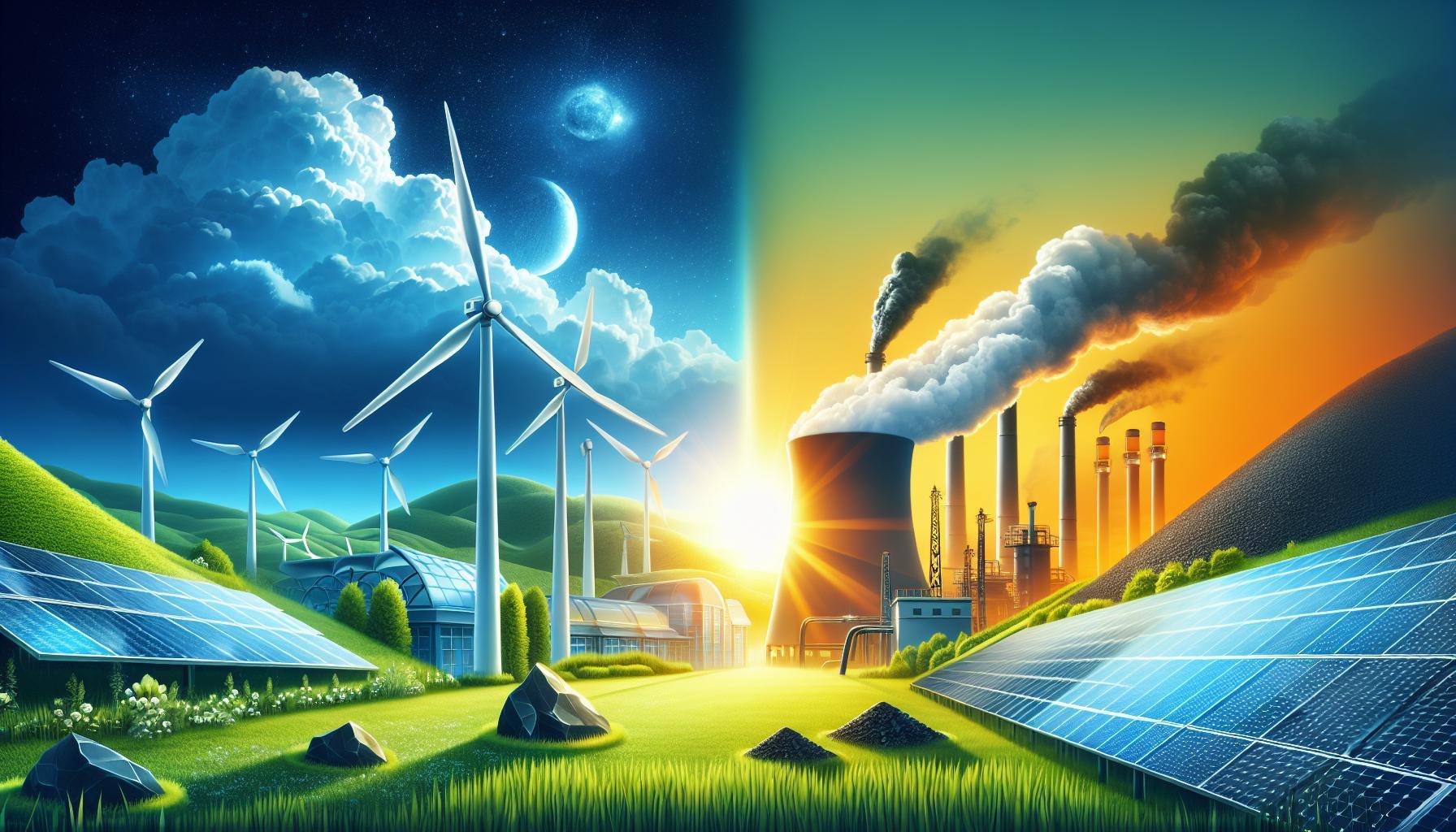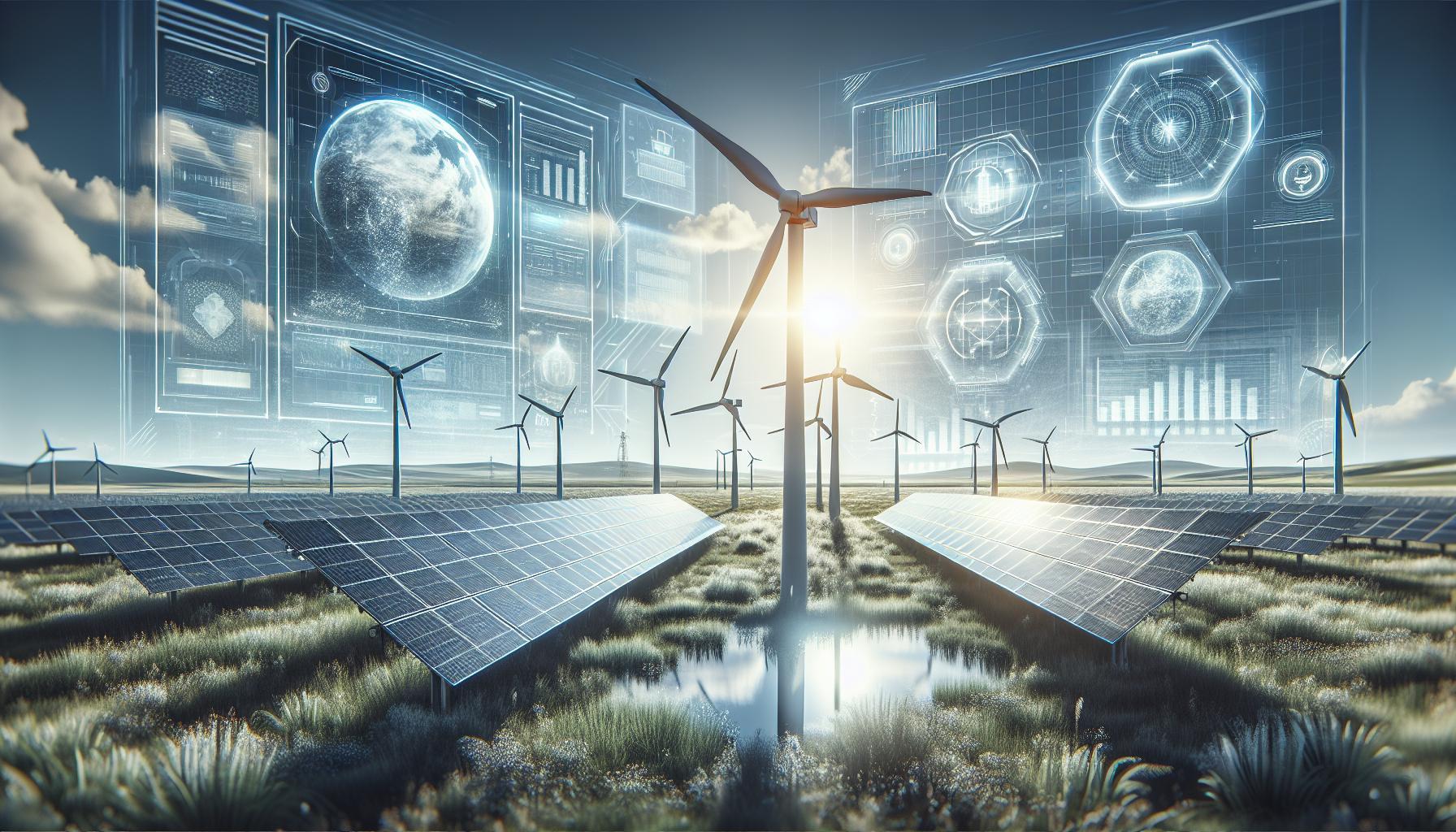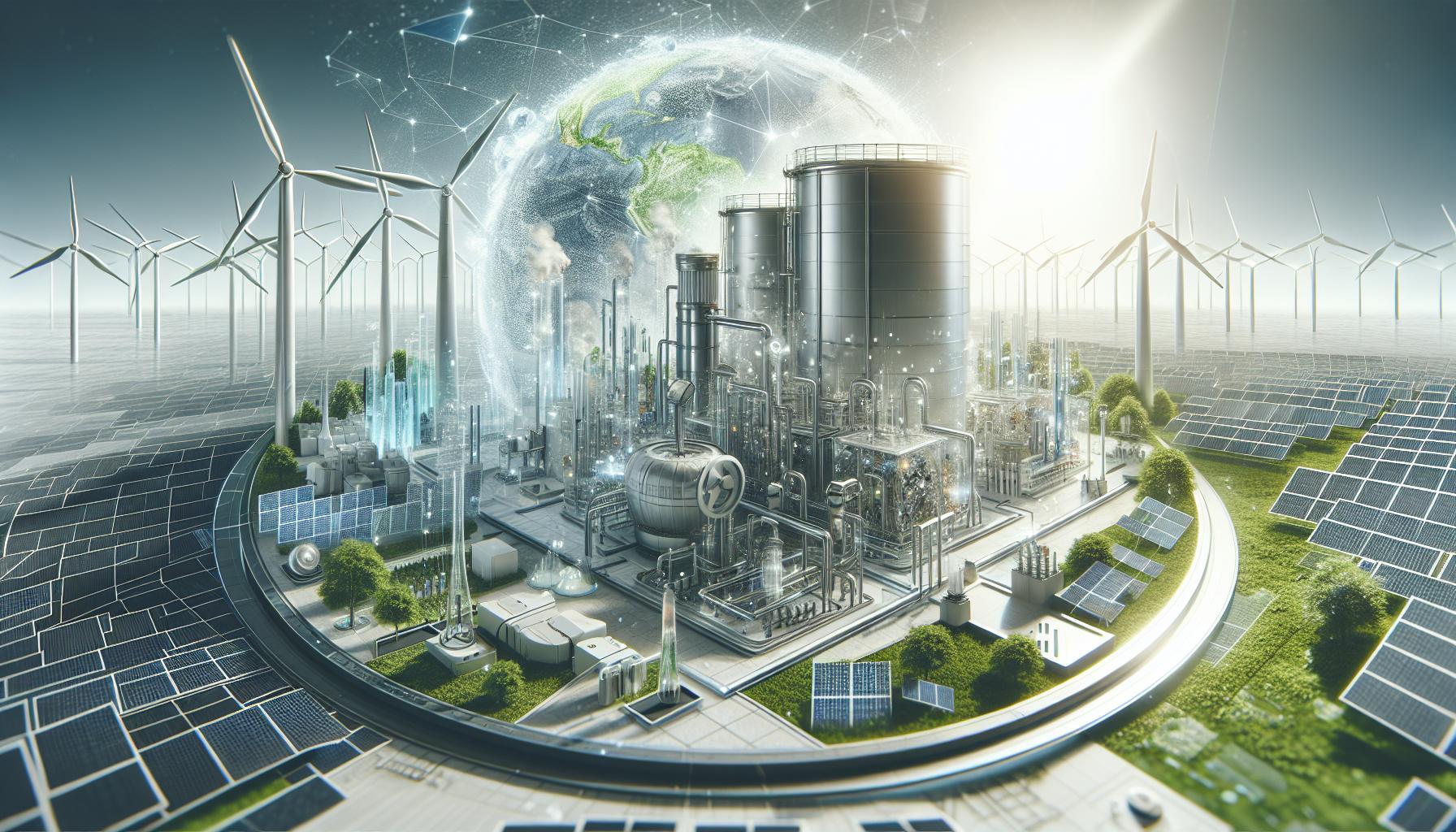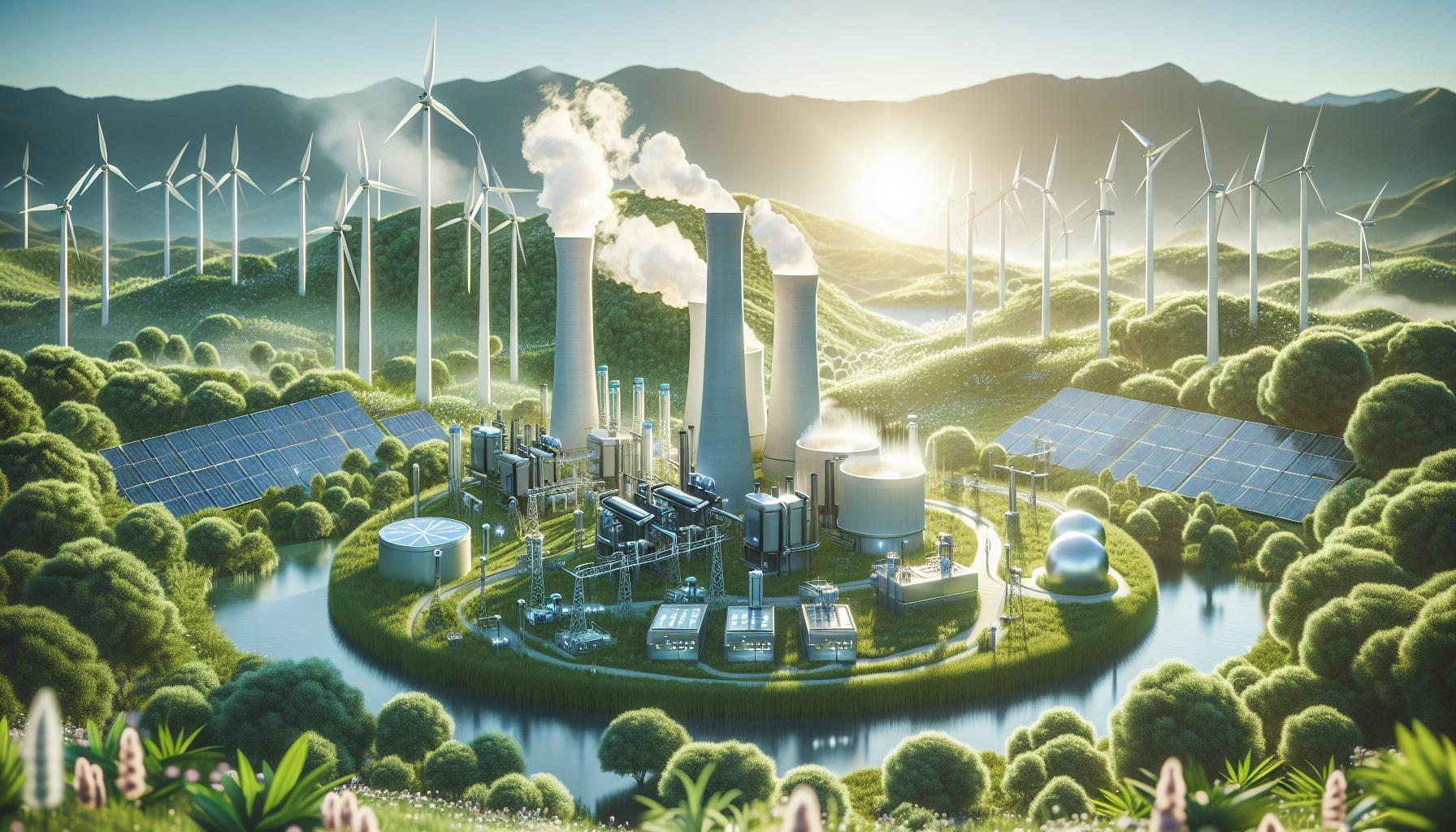Every day, energy powers our lives, from the light in our homes to the fuel in our cars. However, not all energy is created equal. The distinction between renewable and nonrenewable energy sources is crucial for understanding their impacts on our planet and future generations. Renewable resources, like solar and wind, can be replenished naturally, while nonrenewable sources, such as coal and oil, are finite and contribute to environmental degradation as they are consumed.
As we grapple with climate change and energy security, knowing how these energy types affect our world is more important than ever. This knowledge can empower you to make informed choices about energy use and advocate for sustainable practices in your community. Dive into this article to explore the critical differences between renewable and nonrenewable energy sources, and discover how our energy choices can shape a cleaner, healthier future for all.
What Are Renewable Energy Sources?
Imagine a world where electricity flows from endless sources, where the sun shines brightly to power homes and wind turbines spin gracefully, converting the breeze into energy. This is the promise of renewable energy sources, which harness natural processes to produce power sustainably. Unlike fossil fuels, which are finite and damaging to the environment, renewable energy sources can be replenished naturally and have little to no impact on global warming. Today, they form a crucial component of the global energy grid, providing diverse options that include solar, wind, hydroelectric, geothermal, and biomass energy.
Types of Renewable Energy Sources
Renewable energy can be categorized into several main sources, each utilizing different natural phenomena:
- Solar Energy: Captured through solar panels or solar thermal systems, this energy harnesses sunlight to generate electricity or heat water.
- Wind Energy: Generated by wind turbines that convert kinetic energy from wind into electricity, this source is becoming increasingly prominent worldwide.
- Hydropower: The most widely used form of renewable energy, hydropower relies on flowing water to generate electricity, typically from rivers and dams.
- Geothermal Energy: This energy taps into heat from within the Earth, providing a constant source of power for electricity generation and direct heating.
- Biomass Energy: Derived from organic materials, biomass can be converted into biofuels, heat, or electricity, making it a versatile energy option.
The combination of these renewable sources contributes to a sustainable energy future, reducing dependence on fossil fuels and significantly lowering carbon emissions. Each type offers its unique advantages depending on geographic location, climate, and technological advancements, highlighting the importance of a diversified approach toward energy production. With advancements in technology, the efficiency and affordability of harvesting these energy resources continue to improve, energizing efforts around the globe to transition to cleaner, more sustainable energy systems.
Understanding Nonrenewable Energy Sources
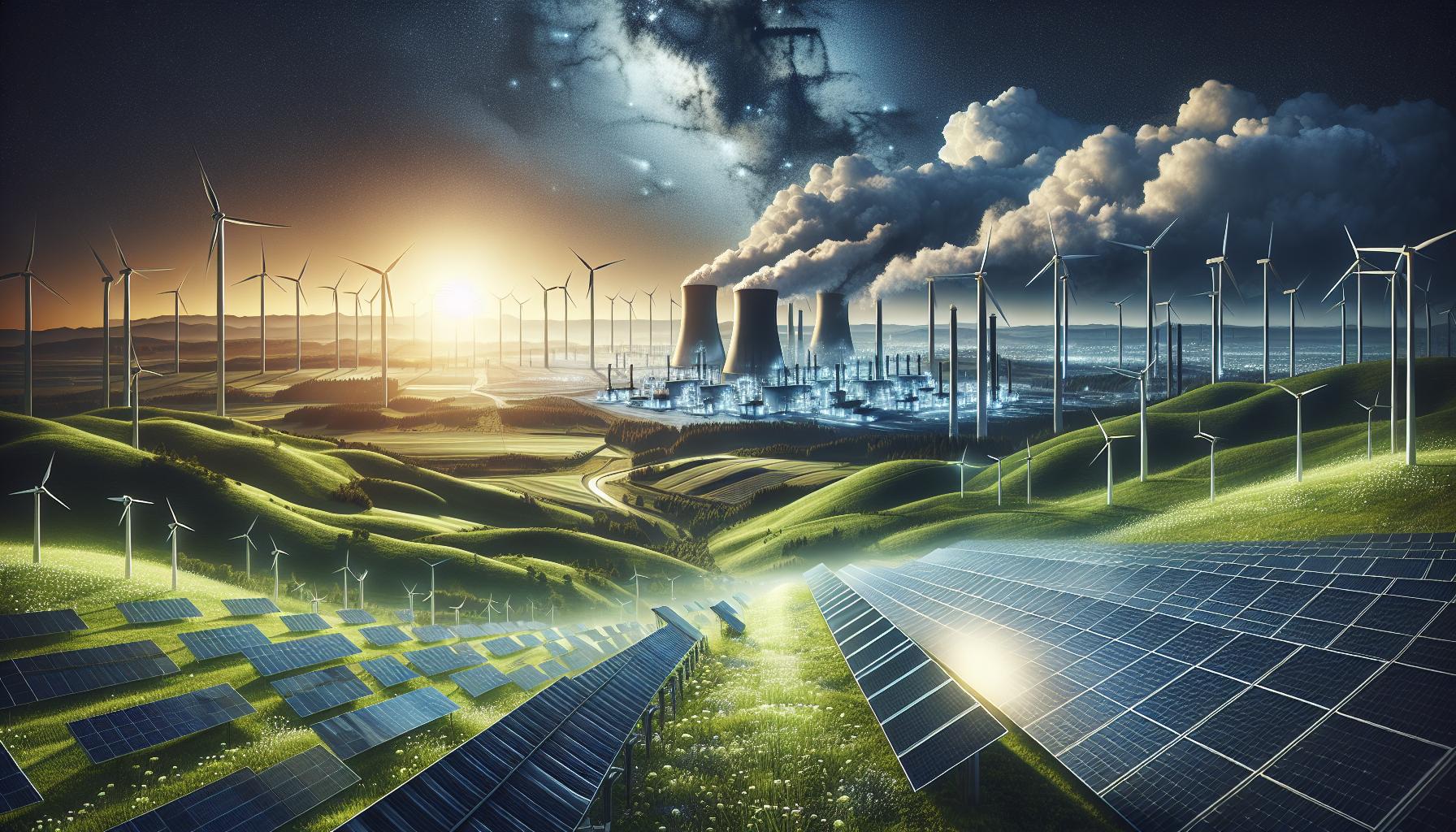
Nonrenewable energy sources are the bedrock of modern energy production but come with significant drawbacks, both environmentally and economically. These energy sources include fossil fuels such as coal, oil, and natural gas, as well as nuclear energy derived from uranium. Unlike renewable energy, nonrenewable resources are finite and will eventually be depleted. Their extraction and use not only contribute to environmental degradation but also play a significant role in global warming due to the greenhouse gases they emit.
The extraction process for nonrenewable sources can be incredibly damaging. For instance, coal mining disrupts ecosystems and poses serious health risks to nearby communities, while oil drilling can lead to catastrophic spills that devastate marine environments. Additionally, burning fossil fuels for energy is one of the largest contributors to air pollution, which affects both public health and climate stability. In contrast to renewable energy sources that harness the power of nature without depleting its resources, nonrenewables create a cycle of consumption that can lead to economic instability as the resources dwindle.
In terms of usage, nonrenewable sources currently provide a majority of the world’s energy needs. However, their declining availability and the rising costs associated with extraction and environmental mitigation are pushing societies to seek alternate solutions. The shift from a fossil fuel dependency to renewable sources is not just a matter of environmental concern-it’s also about ensuring energy security in the long term. This transition is supported by policies aimed at reducing carbon footprints and increasing energy efficiency, emphasizing the need for innovation towards sustainable energy systems.
As the nonrenewable energy landscape continues to evolve, the focus is increasingly on developing cleaner extraction technologies and transitioning to more sustainable practices. The urgency behind adopting renewable sources stems from recognizing that future generations will rely on the choices made today regarding energy consumption and environmental stewardship. Transitioning to cleaner alternative energy sources not only reduces pollution and conserves natural resources but also stimulates innovation and economic growth in emerging green industries.
Key Differences Between Renewable and Nonrenewable Energy
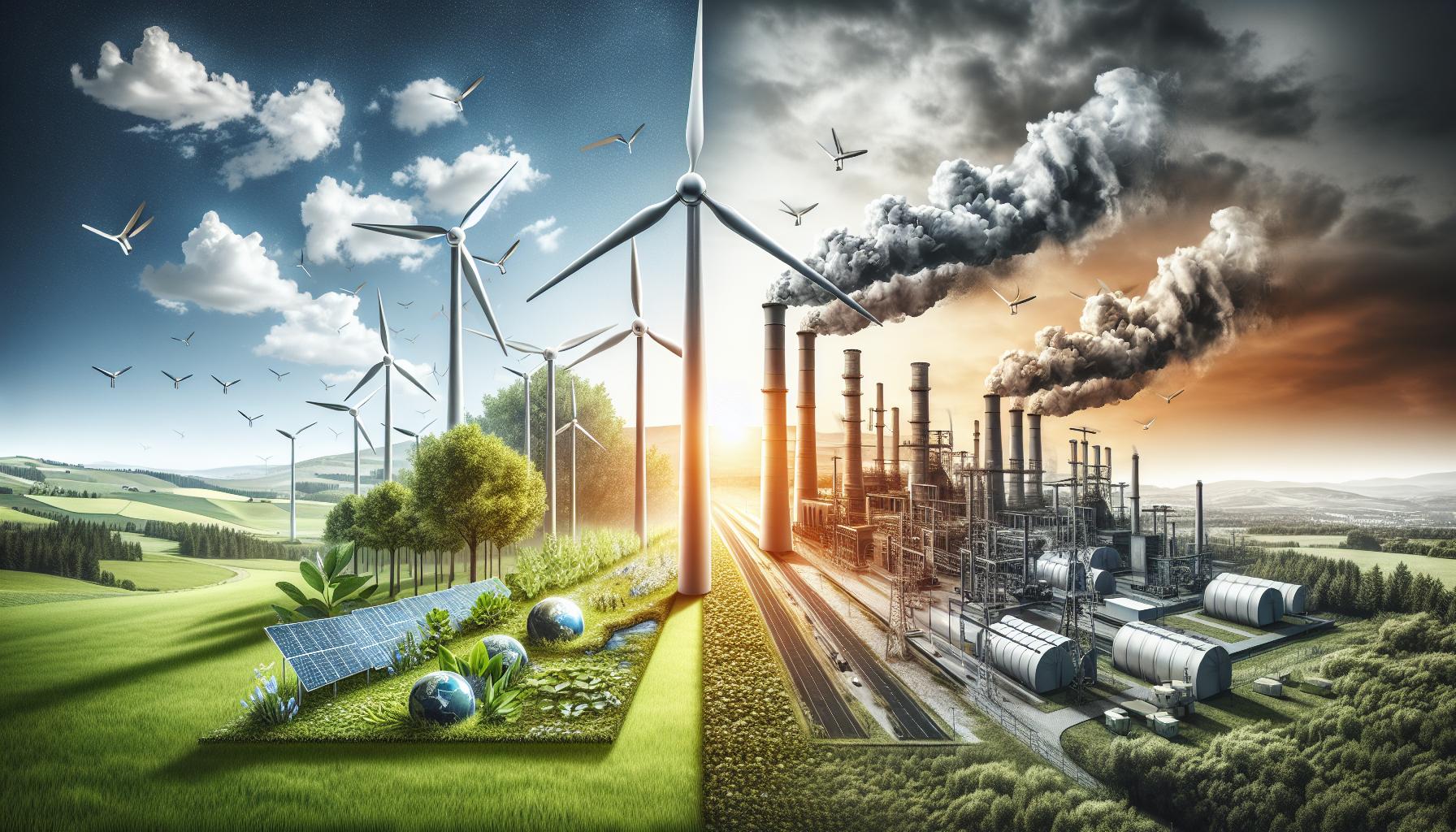
The stark contrast between renewable and nonrenewable energy sources not only shapes our energy landscape but also impacts the health of our planet. While nonrenewable energy sources, such as coal, oil, and natural gas, continue to dominate global energy production, their finite nature raises critical questions about sustainability and long-term viability. In contrast, renewable energy sources-including solar, wind, hydroelectric, and geothermal-offer a sustainable alternative that can be harnessed indefinitely, as these resources are naturally replenished.
One of the most significant differences lies in their availability and sustainability. Nonrenewable energy sources are limited in quantity and will ultimately become exhausted. This creates a reliance on increasingly expensive extraction processes, often resulting in environmental disturbances and geopolitical tension. For example, the search for new oil reserves drives drilling into ecologically sensitive areas, threatening wildlife and natural habitats. Renewable energy, on the other hand, utilizes resources that are abundant and cyclic. The sun shines daily, and the wind blows continually, making these sources accessible in many regions across the globe.
Another notable distinction is the environmental impact of each energy type. Nonrenewable energy is synonymous with pollution and greenhouse gas emissions, contributing significantly to climate change and air quality issues. The burning of fossil fuels releases carbon dioxide and other harmful pollutants into the atmosphere, leading to smog and health problems for millions. In contrast, renewable energy sources generally produce little to no direct emissions during operation. For example, solar panels generate electricity without air pollutants or greenhouse gases, significantly reducing the overall environmental footprint when compared to traditional energy sources.
Energy Production and Technological Advancements
When it comes to energy production, nonrenewable energy is typically easier and cheaper to harvest in the short term but poses long-term risks, including fluctuating prices and supply shortages. This economic instability often leads to volatile energy markets. Renewables, while initially accompanied by higher upfront costs related to technology and infrastructure, benefit from declining prices due to technological advancements and economies of scale. The cost of solar panels has decreased dramatically over the past decade, making solar energy installations increasingly financially attractive for homeowners and businesses alike.
In summary, the differences between renewable and nonrenewable energy sources encompass aspects of sustainability, environmental impact, economic viability, and technological progress. Embracing a transition toward renewable energy sources not only aligns with the global push for sustainability but also offers robust opportunities for economic growth, innovation, and energy independence in a future that prioritizes planetary health. As we invest and innovate in renewable technologies, we pave the way for a cleaner, more resilient energy future.
Advantages of Renewable Energy Sources
The transition to renewable energy is not merely an environmental necessity; it is also a journey full of potential and promise. The numerous make them increasingly appealing to both consumers and policymakers. As resources such as solar, wind, and hydropower are naturally replenished, they offer a sustainable power approach that can reshape our energy landscape.
One of the most compelling benefits is the reduction of greenhouse gas emissions. Unlike fossil fuels, which emit carbon dioxide and other pollutants when burned, renewable energy sources produce little to no emissions during operation. For instance, solar panels harness sunlight to generate electricity without contributing to air pollution, vastly improving air quality over time. This characteristic is crucial in combating climate change, as it significantly decreases the carbon footprint associated with energy production.
Economic Benefits and Job Creation
Shifting towards renewable energy not only supports the environment but also bolsters economic growth. As the demand for green technology rises, so does job creation in various sectors. From manufacturing and installation to maintenance and innovation, the renewable energy sector is proving to be a significant source of employment. According to recent reports, solar and wind industries alone employ millions worldwide. This job growth can stimulate local economies and provide stable employment opportunities while reducing reliance on energy imports.
Additionally, as technology advances, the costs associated with renewable energy installations are declining. The price of solar panels has dropped dramatically in recent years, making solar energy installations more accessible than ever for homeowners and businesses alike. This trend is not only favorable for reducing expenses but also encourages individuals to invest in sustainable practices. Such economic advantages-combined with the environmental benefits-position renewables as a forward-thinking choice for energy production.
In conclusion, the extend far beyond their environmental impact. They offer a sustainable, clean, and increasingly cost-effective alternative to nonrenewable energy, promoting a healthier planet while simultaneously fostering economic growth and job creation. As we continue to innovate and invest in renewable technologies, we enhance our energy independence and advance toward a more sustainable future.
Disadvantages of Nonrenewable Energy Sources
The reliance on nonrenewable energy sources, such as coal, oil, and natural gas, comes with significant drawbacks that impact not only the environment but also economic stability and public health. These energy sources are finite, meaning that once they are depleted, they cannot be replenished within a human timescale. As society has relied heavily on these resources for decades, the consequences of such dependency are becoming increasingly stark.
First and foremost, the environmental impact associated with nonrenewable energy extraction and use is profound. The burning of fossil fuels releases a substantial amount of greenhouse gases, particularly carbon dioxide, which is a leading driver of climate change. Furthermore, activities such as mining and drilling can lead to habitat destruction, water pollution, and soil degradation. For example, oil spills can devastate marine ecosystems, while coal mining can result in toxic leachates contaminating water supplies. This not only endangers wildlife but also poses serious risks to human health by polluting air and drinking water.
In addition to environmental concerns, nonrenewable energy sources can also lead to economic volatility. The prices of these resources are subject to market fluctuations, geopolitical tensions, and natural disasters. Such unpredictability can lead to energy crises, affecting everything from household energy bills to national economies. For instance, rising oil prices can significantly increase transportation costs, leading to inflation in various sectors. Moreover, communities that rely heavily on these industries often face economic uncertainties as resources become scarcer and mines or drilling sites are exhausted.
Public health is another critical area affected by nonrenewable energy sources. Pollution from fossil fuel plants is linked to respiratory diseases, cardiovascular problems, and premature deaths. Communities near these facilities often experience higher rates of illness, leading to increased healthcare costs and lost productivity. The burden of such health impacts tends to disproportionately affect low-income and marginalized populations, illustrating the need for a transition to cleaner energy alternatives.
In summary, while nonrenewable energy sources have historically powered economies and industries, the disadvantages they present-including environmental harm, economic instability, and public health risks-highlight the urgent need for a shift towards renewable energy solutions. By embracing sustainable energy sources, society can foster a healthier future, mitigate climate change, and promote economic resilience.
Environmental Impact of Energy Types
The consequences of energy consumption extend beyond just meeting our electrical needs; they reach deeply into the health of our planet and societies. Renewable energy sources such as wind, solar, and hydro have minimal environmental impacts compared to their nonrenewable counterparts. By harnessing natural, replenishable resources, we can significantly reduce our carbon footprint, lower emissions, and combat climate change. For instance, solar panels generate electricity without releasing greenhouse gases during operation, while wind turbines leverage kinetic energy from the wind to produce power without depleting resources or polluting the atmosphere.
In contrast, nonrenewable energy sources like coal, oil, and natural gas are notorious for their adverse effects on the environment. The combustion of fossil fuels releases a substantial amount of carbon dioxide, a leading greenhouse gas. To illustrate, in 2020, fossil fuel combustion was responsible for approximately 73% of global greenhouse gas emissions, exacerbating global warming and its associated catastrophic consequences. Additionally, the extraction processes for these resources-such as mining and drilling-often lead to habitat destruction, water contamination, and soil degradation. Oil spills, for example, can wreak havoc on marine ecosystems, killing aquatic life and polluting coastlines.
To grasp the full scope of energy production’s impact, consider the pollution generated from coal-fired power plants. These facilities not only emit CO2 but also release harmful pollutants like sulfur dioxide and nitrogen oxides, contributing to smog and respiratory diseases in nearby communities. The health implications can be severe, with studies linking air pollution from fossil fuel use to respiratory and cardiovascular illnesses, leading to increased mortality rates, particularly among vulnerable populations.
Ensuring a Sustainable Future
Transitioning to renewable energy sources is not just a choice but a necessity to mitigate these environmental impacts. Investing in technologies that utilize wind, solar, and geothermal energy can minimize our reliance on polluting energy sources while promoting biodiversity and healthier ecosystems. By adopting renewables, we not only reduce the immediate threats to our environment but also contribute to a sustainable future that supports economic growth and community resilience.
Ultimately, understanding the environmental impacts of different energy types equips individuals, businesses, and policymakers to make informed decisions that herald a shift towards a more sustainable energy landscape, safeguarding our planet for future generations.
Current Technological Advances in Renewables
The renewable energy sector is witnessing a remarkable evolution, driven by technological innovations that enhance efficiency, lower costs, and expand accessibility. For instance, the cost of solar energy has plummeted by over 80% since 2010, making it one of the most affordable energy sources globally. This dramatic decrease has been fueled by advancements in photovoltaic technology, which have improved the conversion efficiency of solar panels. Today, top-tier solar cells can achieve efficiencies of around 25%, enabling greater energy capture even in limited spaces.
In the realm of wind energy, innovations such as larger turbine designs and enhanced blade aerodynamics are transforming energy generation. Modern wind turbines can be towering structures exceeding 200 feet, equipped with blades that can surpass 100 feet in length. These advancements allow turbines to harness wind energy more effectively, producing electricity even at lower wind speeds. Additionally, the introduction of floating wind farms-deployed off-shore in deeper waters-opens vast new areas for energy generation that were previously inaccessible.
Energy Storage Solutions
A crucial component of renewable energy’s evolution lies in energy storage technologies. As the generation of solar and wind energy is inherently intermittent, advancements in battery storage solutions are vital for ensuring a reliable energy supply. Lithium-ion batteries, widely used today, are being joined by innovative technologies such as solid-state batteries, which promise higher energy densities and longer lifespans. Additionally, pumped hydro storage and advanced grid systems are being implemented to balance energy supply with demand, enhancing grid stability and efficiency.
Smart Technologies and Energy Management
The rise of smart technologies is revolutionizing how we manage and utilize renewable energy. Smart grids enable real-time monitoring and distribution of electricity, facilitating the seamless integration of various energy sources into the power supply. Consumers can also participate in energy management through intelligent home systems that optimize usage patterns, further reducing costs and consumption. By leveraging these technologies, households and businesses can not only save money but also contribute to a more sustainable energy future.
Real-world examples underscore this technological shift. Companies such as Tesla are pioneering developments in solar roofing and energy storage with their Powerwall systems, allowing consumers to generate and store renewable energy efficiently. Similarly, countries like Denmark lead the way in wind energy implementation, generating more than 40% of their electricity from wind turbines, showcasing the potential renewables hold for energy independence and sustainability.
As we transition towards a low-carbon future, the strides made in renewable energy technologies not only promise to meet our energy needs but also possess the potential to reshape our economies and communities for the better. Embracing these innovations is essential for fostering a sustainable environment and mitigating the impacts of climate change.
Economic Considerations: Costs and Savings
The economic landscape of energy production is undergoing a significant transformation, driven largely by the dramatic decrease in costs associated with renewable energy technologies. In fact, many renewable resources, particularly solar and wind energy, have reached a point where they can compete head-to-head with traditional fossil fuels. For instance, the cost to install solar photovoltaic systems has dropped by about 82% since 2010, making solar power not only a sustainable choice but also a financially viable one. This evolution has created a compelling case for both new and existing energy consumers to consider transitioning to renewable sources.
Cost Analysis of Renewable Energy
When evaluating the economics of renewable energy, it’s essential to look at both initial investments and long-term savings. Although the upfront costs of installing solar panels or wind turbines can be significant, the long-term savings on electricity bills and potential earnings from selling excess energy back to the grid often justify this investment. For example, homeowners in states with net metering laws can offset costs significantly by supplying surplus energy generated during peak production times. Additionally, as countries worldwide implement policies that encourage renewable adoption, such as tax credits and subsidies, the relative cost of these technologies continues to decline.
Life-Cycle Cost Benefits
Another compelling aspect of renewable energy is its comparatively low life-cycle costs. Unlike nonrenewable sources that incur ongoing fuel costs, renewable technologies generate energy without depleting resources or incurring significant maintenance expenses. Once a solar panel or wind turbine is installed, it can operate for decades with minimal intervention. By transitioning to renewables, organizations and individuals can insulate themselves from the volatility of fossil fuel markets, leading to more predictable and stable energy prices.
Investments and Job Creation
The transition to renewable energy is not just an individual financial decision-it also offers broader economic benefits. Investing in renewable energy technologies creates jobs across various sectors, from manufacturing and installation to maintenance and support services. In the United States, the solar industry alone employed over 250,000 workers in recent years, a number that continues to rise as adoption spreads. This trend reflects an increasingly green workforce that bolsters local economies and contributes to national sustainability goals.
In summary, the shift towards renewable energy sources presents a dual opportunity: significant cost savings for consumers and businesses while fostering economic growth through job creation and investment. By embracing these sustainable energy solutions, society not only addresses climate change but also paves the way for a resilient and economically prosperous future.
Future Trends in Energy Transition
The energy landscape is on the cusp of a transformative shift, as the urgency to address climate change propels innovations and adaptations in how we generate and consume energy. One of the most notable trends is the increasingly decentralized nature of energy production, where consumers are becoming prosumers-individuals or organizations that both consume and produce energy. This transition is largely facilitated by advancements in technology and changing regulatory frameworks, which empower homeowners and businesses to harness renewable sources like solar and wind more effectively.
Rise of Energy Storage Solutions
One of the most critical future trends in the energy transition involves the development of energy storage technologies. As greater amounts of renewable energy are generated, the challenge of intermittency-when energy production does not align with demand-becomes paramount. Innovative solutions such as lithium-ion batteries and pumped hydro storage are gaining traction to overcome this hurdle. These technologies allow for excess energy produced during peak conditions to be stored and utilized during periods of low generation. For example, Tesla’s expansion of its battery storage systems is not only revolutionizing personal energy management for homeowners but also contributing to grid stability on a larger scale.
Smart Grid Integration
The evolution of smart grids is another pivotal trend that will redefine how energy is managed and consumed. Smart grids utilize digital technology to monitor and manage the transmission of electricity, allowing for more efficient use and distribution of renewable energy. This integration enables more effective demand response programs, where energy prices fluctuate based on real-time supply and demand, encouraging consumers to adjust their usage accordingly. Such systems not only optimize energy use but also enhance reliability and reduce the risk of outages-benefiting both consumers and utility operators.
Policy and Community Engagement
As the movement towards renewable energy gains momentum, supportive policies at local, national, and international levels will play a crucial role in sustaining this transition. Governments are increasingly implementing measures to incentivize the adoption of renewables, such as tax offsets, rebates, and renewable energy credits. Community engagement is equally important; initiatives that encourage local renewable energy projects can foster a sense of ownership and collective responsibility. For instance, community solar projects allow multiple stakeholders to share the benefits of a solar installation, effectively democratizing access to renewable energy.
In conclusion, the future of the energy transition is not simply about shifting from nonrenewable to renewable sources; it encompasses a holistic approach that includes technological advancements, policy support, and community involvement. As innovations in energy storage and smart grid technology emerge, coupled with proactive governmental policies, the path toward a cleaner and more sustainable energy future is not just a possibility-it is a reality that is materializing before our eyes. Adopting these solutions en masse will not only mitigate environmental impacts but also foster resilient economies poised for growth.
Global Policies and Initiatives Supporting Renewables
The transition to renewable energy sources is increasingly gaining traction on a global scale, driven not only by environmental imperatives but also through robust policy frameworks and innovative initiatives. Governments around the world recognize the vital role they play in facilitating this transition, and a myriad of approaches is emerging to make renewable energy more accessible, affordable, and viable. For instance, according to the International Renewable Energy Agency (IRENA), global investment in renewable energy surged to over $300 billion in the last year alone, showcasing the economic momentum behind this shift.
To bolster the adoption of renewables, many countries are enacting policies that create incentives for both producers and consumers. These can include tax credits, subsidies for clean energy technology, and renewable energy mandates that require utility companies to source a certain percentage of their energy from renewable sources. A prime example is the United States’ Investment Tax Credit (ITC), which has been instrumental in driving solar installations. By allowing homeowners and businesses to deduct a significant percentage of the cost of their solar systems from federal taxes, the ITC has made solar energy a financially viable option for many.
Various international frameworks also support the transition to renewable energy. The Paris Agreement, for instance, serves as a catalyst for commitments from nations to reduce greenhouse gas emissions and enhance the share of renewables in their energy mix. Countries like Denmark and Germany are leading the way, showcasing ambitious targets to supply a significant portion of their power from wind and solar energy. These examples exemplify how global collaboration can lead to substantial advances in renewable energy adoption.
Community-Centric Initiatives
Beyond governmental policies, community-led initiatives are increasingly important in the renewable energy landscape. Grassroots movements and local projects not only reduce reliance on fossil fuels but also strengthen community ties and local economies. For example, community solar projects allow residents to invest in a shared solar installation, reaping benefits from energy savings while expanding access to renewable resources. This model democratizes energy production, making it more achievable for people who may not have suitable roofs or the upfront capital for solar panels.
In essence, the convergence of supportive policies, economic incentives, and community engagement forms the backbone of a global movement toward renewable energy. These initiatives not only help to mitigate climate change but also pave the way for more resilient and sustainable energy systems that are less susceptible to the volatility of fossil fuel markets. By embracing these changes, individuals and communities alike can play a crucial role in forging a clean energy future.
Real-World Examples of Energy Solutions
Exploring effective energy solutions in the renewable sector illustrates the immense potential for sustainable practices around the world. Nations are adopting innovative approaches to harness natural resources, reducing their reliance on nonrenewable energy sources like coal and oil. A prime example comes from the remarkable strides made by countries like Sweden and Costa Rica, which are often celebrated for their aggressive initiatives in renewable energy. As of 2022, Costa Rica ran on over 99% renewable energy, primarily sourced from hydropower, wind, and solar. This commitment highlights how countries can lead by setting ambitious targets and investing in infrastructure that supports green technology.
In addition to national efforts, cities are increasingly becoming hubs of innovation in renewable energy. For instance, San Diego, California, is at the forefront of urban renewable energy efforts, aiming for 100% renewable energy by 2035. By launching extensive solar energy initiatives and creating partnerships with local businesses and institutions, San Diego not only reduces its carbon footprint but also stimulates local economic growth. The San Diego Community Power program allows residents to choose green energy options that support local renewable resources, facilitating wider adoption of sustainable practices in day-to-day life.
Community solar projects represent another exciting development in renewable energy solutions. These initiatives enable multiple households or businesses to share the financial benefits of a single solar installation, eliminating barriers for those who cannot afford individual setups. A notable success story is the Solar Gardens program in Colorado, where participants invest in shared solar arrays and receive credits toward their electricity bills. This approach democratizes access to renewable energy, making it an achievable goal for individuals and communities regardless of their financial resources or suitable rooftops for solar installations.
The transition to renewable energy isn’t just a trend but a critical imperative for our planet’s future. From municipal projects to community solutions, these real-world examples showcase not only the feasibility of renewable energy but also its capacity to foster economic growth, create jobs, and empower citizens. By embracing these energy solutions, individuals and communities are playing an essential role in building sustainable energy systems that prioritize the health of the planet while paving the way for an economically viable future.
How to Transition to Renewable Energy
Switching to renewable energy is one of the most impactful actions individuals and communities can take to combat climate change and reduce reliance on fossil fuels. The transition requires careful planning, education, and often, cooperation among multiple stakeholders. By following a structured approach, it is possible to effectively transition to renewable energy sources, maximize their benefits, and contribute to a more sustainable future.
One strategic method to initiate this transition is by conducting a comprehensive energy audit. This process evaluates current energy usage and identifies areas for improvement, including potential renewable energy solutions tailored to specific needs. Here are key steps to consider:
- Assess Energy Needs: Understand how much energy your household or business consumes on a monthly basis. This provides a baseline to determine the scale of renewable energy required.
- Explore Renewable Options: Research the available renewable energy technologies suitable for your situation. Solar panels, wind turbines, geothermal, and biomass are popular choices that can meet varying energy demands.
- Evaluate Local Policies and Incentives: Different regions offer unique financial incentives or rebates for renewable energy installations. Reviewing these options can significantly reduce initial costs.
- Engage with Local Experts: Consulting with renewable energy professionals helps in understanding local resources and technologies available. They can offer invaluable insights into effective installations tailored to regional characteristics.
Additionally, community initiatives can amplify individual efforts. For example, collective purchasing programs allow residents to benefit from bulk rates on solar installations, making the technology more affordable. Such collaborations can also foster a supportive network for ongoing maintenance and optimization of energy systems.
Real-World Examples of Transition
Several cities and countries have made remarkable strides in transitioning to renewable energy, providing models for others to follow. Germany stands as a pioneer in its “Energiewende” plan, aiming to transition entirely to sustainable energy sources through a combination of wind, solar, and hydroelectric projects. Local governments encourage initiatives that prioritize energy efficiency alongside renewable installations, creating a resilient energy network.
In the United States, Minnesota’s “Community Solar Gardens” program offers another compelling example. Here, residents can invest in shared solar installations, enjoying the economic benefits collectively. Such models offer pathways for participation, especially for those who might not have suitable roofs for solar panels.
Embracing renewable energy is not just about adopting new technologies; it’s about rethinking our consumption practices, fostering community collaboration, and committing to sustainability for the generations ahead. Every step taken-no matter how small-contributes to a larger movement toward a resilient, sustainable energy future.
Frequently Asked Questions
Q: What is the main difference between renewable and nonrenewable energy sources?
A: The main difference is that renewable energy sources, such as solar and wind, can be replenished naturally over time, while nonrenewable energy sources, like coal and oil, are finite and will deplete eventually. This impacts sustainability and environmental health significantly.
Q: Why is renewable energy considered more environmentally friendly?
A: Renewable energy is considered more environmentally friendly because it produces little to no greenhouse gas emissions during operation, reducing pollution and contributing to a healthier planet. This contrasts with nonrenewable sources, which emit high levels of CO2 and other harmful pollutants.
Q: What are some examples of renewable energy sources?
A: Examples of renewable energy sources include solar power, wind power, geothermal energy, hydroelectricity, and biomass. These sources harness natural processes and are sustainable over long periods.
Q: How do nonrenewable energy sources impact climate change?
A: Nonrenewable energy sources significantly contribute to climate change through greenhouse gas emissions from burning fossil fuels. This accelerates global warming, leading to severe environmental impacts, including changing weather patterns and increased natural disasters.
Q: When is renewable energy more cost-effective than nonrenewable energy?
A: Renewable energy can be more cost-effective than nonrenewable energy when considering long-term operational costs, government incentives, and decreasing technology prices. Over time, renewables often provide financial savings while mitigating environmental impacts.
Q: How do renewable and nonrenewable energy sources affect energy security?
A: Renewable energy sources enhance energy security by reducing dependence on imported fuels and diversifying the energy supply. Nonrenewable sources are often subject to geopolitical tensions and market volatility, leading to supply risks.
Q: What is the future of renewable energy compared to nonrenewable energy?
A: The future of renewable energy is promising, with advancements in technology and increasing global commitments to combat climate change. In contrast, nonrenewable energy sources face declining investments and regulatory pressures, indicating a shift towards sustainable practices.
Q: Where can individuals learn more about renewable energy options?
A: Individuals can learn more about renewable energy options through government websites, local energy providers, and educational platforms that offer resources on installation, benefits, and financial incentives. Exploring community solar projects and workshops can also be beneficial.
For further exploration of the differences between energy sources, consider checking resources on renewable energy innovations and trends in the energy market.
Final Thoughts
As we’ve explored the critical distinctions between renewable and nonrenewable energy sources, it’s clear that understanding these differences can empower you to make informed decisions about energy usage. Remember, by embracing renewable options, not only are you contributing to a sustainable future, but you also have the opportunity to reduce long-term energy costs.
If you found this discussion valuable, consider checking out our articles on the benefits of solar energy and how wind power is reshaping energy production to deepen your understanding. Join our community by signing up for our newsletter for the latest insights and updates! Have questions or thoughts? We’d love to hear from you in the comments below. Let’s continue this journey towards clean energy solutions together-explore further and take action today!

